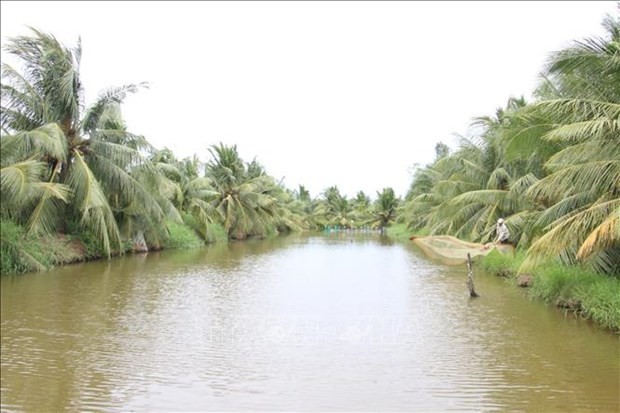
Ben Tre to develop sustainable aquaculture, fisheries
Latest
 |
| A pond for farming giant river prawns in Ben Tre province’s Thanh Phu district. (Photo: VNA) |
A plan it has drafted for the purpose envisages the maritime economy accounting for 30% of its economy by 2030.
The goal from now until 2030 is to increase output by 17.4% annually.
The proportion of export value of value-added processed seafood products reached an average of over 40%, of which shrimp reached 50%, pangasius reached 20%, clams reached 50%, and other aquatic products reached 40%.
The province's key fisheries products are black tiger shrimp, white-legged shrimp, clams, giant river prawns, and tra fish.
Nguyen Truc Son, Vice Chairman of the People’s Committee, said to achieve the targets, more investments would be made in infrastructure in aquaculture areas in three coastal districts that use advanced techniques.
Models that help adapt to climate change would be expanded, he said.
The focus would also be on the use of advanced techniques in fishing, processing and preservation of seafood that have high value and demand, he said.
The province has 11 seafood processing plants with an annual output of 72,000 tonnes, mostly of frozen tra fish, clam and shrimp.
The aquaculture area has increased rapidly in recent years, with the key items being marine shrimp, tra fish and clam.
The province will focus on aquaculture models that use advanced techniques and are biologically safe and environment-friendly.
Its Department of Agriculture and Rural Development said aquaculture would be developed in an effective and sustainable manner with a diverse range of creatures bred using methods that suit each locality.
Hi-tech farming
The agricultural department said the province would proactively switch from traditional to hi-tech breeding methods, adopt good agricultural practices and origin traceability, and ensure bio-safety and environmental protection.
This year it aims to develop at least 500ha of hi-tech farms for breeding brackish-water shrimp, taking the total to 2,500ha, he said.
The People’s Committee has unveiled a plan for having 4,000ha of hi-tech shrimp farms by 2025, 2,500ha in Binh Dai, 1,500ha in Thanh Phu and 500ha in Ba Tri.
Some companies have begun hi-tech shrimp farming in the three coastal districts while the province is investing in infrastructure for hi-tech farming there.
Authorities are also reviewing aquaculture zoning, developing hi-tech aquaculture areas and expanding efficient breeding models like two-stage shrimp farming.
All intensive farming areas raising key aquatic species will meet Vietnamese good agricultural practices (VietGAP) or other standards such as GlobalGAP and Aquaculture Stewardship Council (ASC).
The province plans to set up five or six new seafood processing plants, including two to three for shrimp. It will develop a marine economic industrial park in Thanh Phu district.
It will also develop linkages between small fisheries breeding establishments to create large breeding areas and also link them with businesses to ensure supply of inputs and customers for their harvests.
Along with aquaculture, it will also expand offshore fishing and revamp its fishing fleet to sustainably exploit marine resources.
The number of near-shore fishing boats will be reduced from 4,680 to 3,528 by 2030.
Nguyen Van Buoi, Deputy Director of the provincial Department of Agriculture and Rural Development, said near-shore fishing and overexploitation of seafood stocks would be reduced.
After the number of fishing boats is regulated, fishermen who lose their livelihoods would be assisted with switching to other occupations, he assured.
From now until 2030 the province will also implement advocacy programmes and projects to regulate exploitation and ensure protection of fisheries resources.
It plans to establish community-based models to make fishing sustainable.
It will arrange its fishing boats into fleets for better management, categorising them into less than 12 metres long, between 12 and 15 metres and more than 15 metres.
In March last year the province started the installation of black boxes in offshore fishing boats with a length of at least 15 metres to locate them at all times.
Almost all 1,962 offshore boats have installed the box already, including all of them with a length of more than 24 metres.
The province has set up 160 offshore fishing groups comprising 2,043 boats, enabling them to stay longer at sea and increase their catch.
The province, which has a coastline of 65 kilometres, has advantages in terms of aquaculture, fishing and seafood processing, and has exploited its marine economy well in recent years.

























